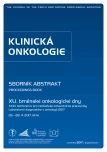-
Medical journals
- Career
Application of PLA Method for Detection of p53/p63/p73 Complexes in Situ in Tumour Cells and Tumour Tissue
Authors: V. Hrabal; M. Nekulová; R. Nenutil; J. Holčáková; P. J. Coates; B. Vojtěšek
Authors‘ workplace: RECAMO, Masarykův onkologický ústav, Brno
Published in: Klin Onkol 2017; 30(Supplementum1): 159-162
Category: Article
Overview
Background:
PLA (proximity ligation assay) can be used for detection of protein-protein interactions in situ directly in cells and tissues. Due to its high sensitivity and specificity it is useful for detection, localization and quantification of protein complexes with single molecule resolution. One of the mechanisms of mutated p53 gain of function is formation of proten-protein complexes with other members of p53 family – p63 and p73. These interactions influences chemosensitivity and invasivity of cancer cells and this is why these complexes are potential targets of anti-cancer therapy. The aim of this work is to detect p53/p63/p73 interactions in situ in tumour cells and tumour tissue using PLA method.Material and Methods:
Unique in-house antibodies for specific detection of p63 and p73 isoforms were developed and characterized. Potein complexes were detected using PLA in established cell lines SVK14, HCC1806 and FaDu and in paraffin sections of colorectal carcinoma tissue. Cell lines were also processed to paraffin blocks.Results:
p53/T-antigen and ΔNp63/T-antigen protein complexes were detected in SVK14 cells using PLA. Interactions of ΔNp63 and TAp73 isoforms were found in HCC1806 cell line with endogenous expression of these proteins. In FaDu cell line mut-p53/TAp73 complex was localized but not mut-p53/ΔNp63 complex. p53 tetramer was detected directly in colorectal cancer tissue.Conclusion:
During development of PLA method for detection of protein complexes between p53 family members we detected interactions of p53 and p63 with T-antigen and mut-p53 and ΔNp63 with TAp73 tumour suppressor in tumour cell lines and p53 tetramers in paraffin sections of colorectal cancer tissue. PLA will be further used for detection of p53/p63, p53/p73 and p63/p73 interactions in tumour tissues and it could be also used for screening of compounds that can block formation of p53/p63/p73 protein complexes.Key words:
p53 protein family – protein interaction mapping – immunofluorescence
This work was supported by MEYS – NPS I – LO1413.
The authors declare they have no potential conflicts of interest concerning drugs, products, or services used in the study.
The Editorial Board declares that the manuscript met the ICMJE recommendation for biomedical papers.Submitted:
13. 3. 2017Accepted:
26. 3. 2017
Sources
1. Söderberg O, Gullberg M, Jarvius M et al. Direct observation of individual endogenous protein complexes in situ by proximity ligation. Nat Methods 2006; 3 (12): 995–1000.
2. Oren M, Rotter V. Mutant p53 gain-of –function in cancer. Cold Spring Harb Perspect Biol 2010; 2 (2): a001107. doi: 10.1101/cshperspect.a001107.
3. Melino G. p63 is a suppressor of tumorigenesis and metastasis interacting with mutant p53. Cell Death Differ 2011; 18 (9): 1487–1499. doi: 10.1038/cdd.2011.81.
4. Di Como CJ, Gaiddon C, Prives C. p73 function is inhibited by tumor-derived p53 mutants in mammalian cells. Mol Cell Biol 1999; 19 (2): 1438–1449.
5. Davison TS, Vagner C, Kaghad M et al. p73 and p63 are homotetramers capable of weak heterotypic interactions with each other but not with p53. J Biol Chem 1999; 274 (26): 18709–18714.
6. Leong CO, Vidnovic N, DeYoung MP et al. The p63/p73 network mediates chemosensitivity to cisplatin in a biologically defined subset of primary breast cancers. J Clin Invest 2007; 117 (5): 1370–1380.
7. Adorno M, Cordenonsi M, Montagner M et al. A mutant-p53/Smad complex opposes p63 to empower TGFbeta-induced metastasis. Cell 2009; 137 (1): 87–98. doi: 10.1016/j.cell.2009.01.039.
8. Muller PA, Caswell PT, Doyle B et al. Mutant p53 drives invasion by promoting integrin recycling. Cell 2009; 139 (7): 1327–1341. doi: 10.1016/j.cell.2009.11. 026.
9. Nekulova M, Holcakova J, Nenutil R et al. Characterization of specific p63 and p63-N-terminal isoform antibodies and their application for immunohistochemistry. Virchows Arch 2013; 463 (3): 415–425. doi: 10.1007/s00428-013-1459-4.
10. Pipas JM, Levine AJ. Role of T antigen interactions with p53 in tumorigenesis. Semin Cancer Biol 2001; 11 (1): 23–30.
Labels
Paediatric clinical oncology Surgery Clinical oncology
Article was published inClinical Oncology

2017 Issue Supplementum1-
All articles in this issue
- MicroRNA Analysis in Epithelial Ovarian Cancer
- Use of Porous Hydrogel as a 3D Scaffold for the Growth of Leukemic B Lymphocytes
- Ascites May Provide Useful Information for Diagnosis of Ovarian Cancer
- Diagnostic and Therapeutic Potential of Membrane HSP90
- Everolimus in Daily Clinical Practice Focusing to Oral Mucosa Damage Issues – Single Oncology Centre Experience within the Course of the Year 2016
- Analysis of DNA Methylation in BRCA2 Gene Using Electrode Biochips
- Molecular Pathology of Colorectal Cancer, Microsatellite Instability – the Detection, the Relationship to the Pathophysiology and Prognosis
- Lactate Dehydrogenase – Old Tumour Marker in the Light of Current Knowledge and Preanalytic Conditions
- Application of PLA Method for Detection of p53/p63/p73 Complexes in Situ in Tumour Cells and Tumour Tissue
- The Importance of MicroRNA Deregulation in the Molecular Pathogenesis and Histological Transformation of Follicular Lymphoma
- Circulating Myeloid Suppressor Cells and Their Role in Tumour Immunology
- Can we Observe Ethnic Difference in Basic Blood Tests? Single-institution Data from Cancer Prevention Programme in the Czech Republic
- Zinc-modified Nanotransporter for Target Drug Therapy of Breast Cancer
- Fullerene Doxorubicin Nanotransporter for Target Interaction with mutated gene BRCA2
- Clinical Oncology
- Journal archive
- Current issue
- Online only
- About the journal
Most read in this issue- Ascites May Provide Useful Information for Diagnosis of Ovarian Cancer
- Lactate Dehydrogenase – Old Tumour Marker in the Light of Current Knowledge and Preanalytic Conditions
- Molecular Pathology of Colorectal Cancer, Microsatellite Instability – the Detection, the Relationship to the Pathophysiology and Prognosis
- Circulating Myeloid Suppressor Cells and Their Role in Tumour Immunology
Login#ADS_BOTTOM_SCRIPTS#Forgotten passwordEnter the email address that you registered with. We will send you instructions on how to set a new password.
- Career
